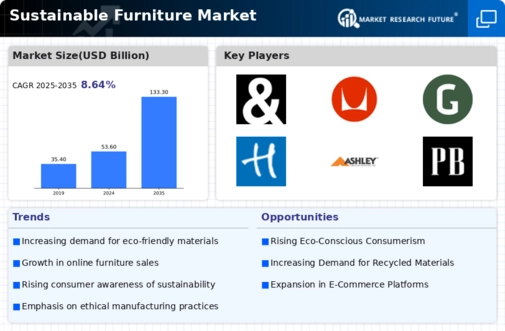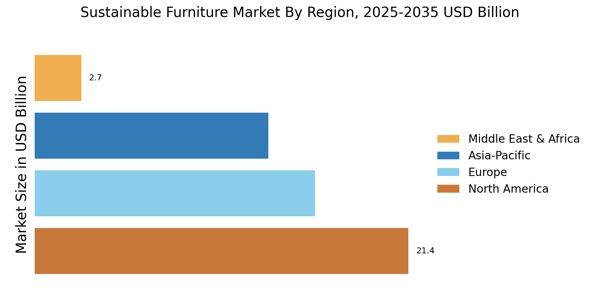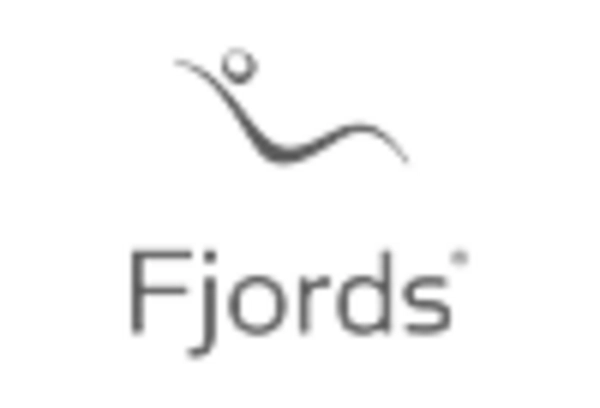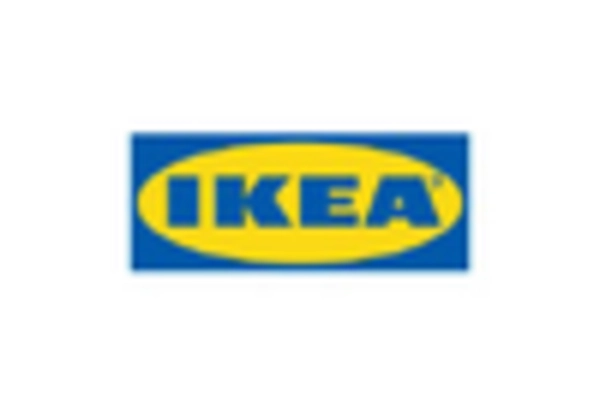Increased Environmental Awareness
The Sustainable Furniture Market is experiencing a notable surge in consumer awareness regarding environmental issues. As individuals become more conscious of their ecological footprint, they are increasingly seeking furniture options that align with their values. This shift is reflected in market data, indicating that approximately 70% of consumers are willing to pay a premium for sustainable products. This growing demand for eco-friendly furniture is driving manufacturers to innovate and adopt sustainable practices, thereby enhancing their market presence. Furthermore, the emphasis on sustainability is not limited to consumers; businesses are also recognizing the importance of corporate social responsibility, leading to a broader commitment to sustainable sourcing and production methods. As a result, the Sustainable Furniture Market is poised for continued growth as more consumers prioritize environmentally responsible choices.
Rise of E-Commerce and Online Retail
The Sustainable Furniture Market is being transformed by the rise of e-commerce and online retail platforms. As consumers increasingly turn to online shopping for convenience, the demand for sustainable furniture options is also growing. E-commerce platforms provide a unique opportunity for sustainable furniture brands to reach a wider audience, allowing them to showcase their eco-friendly products to consumers who may not have access to local retailers. Market data indicates that online sales of sustainable furniture have surged by over 40% in the last year, reflecting a significant shift in purchasing behavior. This trend not only facilitates greater accessibility to sustainable options but also encourages competition among brands to innovate and improve their offerings. As a result, the Sustainable Furniture Market is likely to see continued growth driven by the expanding online retail landscape.
Consumer Preference for Customization
The Sustainable Furniture Market is increasingly influenced by consumer preferences for customization and personalization. As consumers seek unique and tailored solutions for their living spaces, furniture manufacturers are responding by offering customizable options that align with sustainable practices. This trend is evident in the growing demand for made-to-order furniture, which allows consumers to select materials, colors, and designs that reflect their individual tastes while adhering to sustainability standards. Market data suggests that the customization segment within the sustainable furniture sector has grown by approximately 25% in recent years. This shift not only enhances consumer satisfaction but also promotes responsible consumption, as customized furniture is often designed to last longer and reduce waste. Consequently, the Sustainable Furniture Market is adapting to these preferences, fostering innovation and sustainability in product offerings.
Government Regulations and Incentives
The Sustainable Furniture Market is significantly influenced by government regulations aimed at promoting sustainability. Various countries have implemented policies that encourage the use of sustainable materials and practices in furniture production. For instance, regulations that limit the use of harmful chemicals in manufacturing processes are becoming more prevalent. Additionally, governments are offering incentives for companies that adopt sustainable practices, such as tax breaks or grants for using renewable resources. This regulatory environment not only fosters innovation within the industry but also enhances consumer trust in sustainable products. As a result, businesses that comply with these regulations are likely to gain a competitive edge in the Sustainable Furniture Market, appealing to a growing segment of environmentally conscious consumers.
Shift Towards Minimalism and Functional Design
The Sustainable Furniture Market is witnessing a shift towards minimalism and functional design, driven by changing consumer preferences. As urban living spaces become smaller, consumers are increasingly favoring furniture that is not only aesthetically pleasing but also space-efficient and multifunctional. This trend aligns with sustainable practices, as it encourages the use of fewer resources and promotes longevity in furniture design. Market data suggests that minimalist furniture sales have increased by approximately 30% over the past year, indicating a strong consumer preference for simplicity and functionality. Consequently, manufacturers are adapting their designs to meet this demand, leading to a more sustainable approach in the Sustainable Furniture Market. This evolution in design philosophy is likely to continue shaping the market landscape in the coming years.


















Leave a Comment